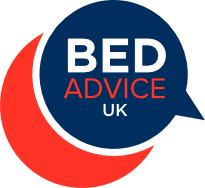
A-Z of Bed and Mattress Terminology
Do you know your ottomans from your orthopaedics? Don’t let bed industry jargon stop you from understanding the different types of beds and mattresses and, importantly, from finding the one that’s right for you.
Here’s a list of the need-to-know bed and mattress terminology that you might see online or in-store during your bed-buying journey.
Why not Bookmark or Favourite this page when you need it?
Adjustable bed base. An electrically operated or manual bed frame construction that permits the raising and lowering of the head and/or foot portions of the mattress.
Bed in a box. Also known as a mattress-in-a-box or a roll-up mattress. Delivered tightly rolled up in a box and usually vacuum sealed.
Divan. An upholstered box, fitted with castors or legs to support the mattress, available as sprung edge, solid/platform top or firm edge. Can also include storage drawers or lift-up storage (ottomans).
Hypoallergenic. A term to describe a material or a product that does not provoke an allergic reaction.
Latex. A flexible foam created from a water dispersion of rubber, either from the rubber tree (natural latex) or a man-made, petroleum-based product (synthetic latex). Most latex used in mattresses today is a combination of natural and synthetic latex rubber.
Memory foam, known as visco-elastic. Responds to individual shape and pressure, has good pressure-relieving properties and is available in a variety of qualities and densities.
Natural mattress. Usually refers to a premium quality material derived from the sap of the rubber tree. The material has a distinctive, resilient feel, is very durable and has anti-microbial properties that offer benefits to many allergy sufferers. Its natural elasticity means it recovers its shape immediately when pressure is removed. It also has excellent point elasticity, resulting in an even distribution of pressure for independent support.
No Turn or Non-Turn, or ‘single-sided’ mattresses have only one sleeping surface, so don’t require turning (flipping) over. We recommend that you still regularly rotate your mattress, however from end to end.
Orthopaedic is a widely used term to incorrectly imply the mattress is good for bad backs and/or gives proper postural alignment and firm support. Adequate support with a degree of comfort to contour to the body is best.
Ottoman. A divan base or bedframe with lift-up storage offering a much larger capacity than drawers.
Overlay. A mattress topper.
Pocket spring. Pocket sprung mattresses have a type of innerspring construction in which thin barrel-shaped, knotless coils are encased in fabric pockets. They use small, softer springs that work independently from each other and conform and adjust to body contours.
Quilting. The surface treatment is mainly on mattresses in which the cover, foam and/or other fibres are sewn together, using various stitch patterns.
Settlement. Body-shaped impressions that form where the user lies, also known as dipping. A normal characteristic of quality mattresses where the upholstery fillings are compact. Regular turning will minimise this, although it will occur to differing degrees depending on the user’s weight and the number of fillings. It does not signify that the mattress has sagged.
Slatted base. Mostly used with bedsteads, these can be either rigid or flexible. Rigid slats are often made from pine and offer a firm feel, whereas flexible slats are made from laminated softwoods and are bowed to offer a softer ‘springy’ support.
Spring count refers to how many coils are used in a mattress’s spring unit. Changing the spring construction, thickness (gauge) of the wire, the number of coils, the height of each spring and the quantity alters the tension, feel and weight distribution properties of each mattress. Find out more about the different types of spring mattresses.
Ticking is the mattress cover and needs to be tough and tear-resistant. Ticking with special qualities is now also increasingly being used by mattress manufacturers. Some of the options include anti-dust mite/anti-allergy, anti-bacterial, anti-microbial, anti-static, breathable, water resistant, stain resistant, highly absorbent, naturally fire retardant, etc.
Tufting. Consists of passing cords or tape through the mattress from top to bottom, knotting and securing the loops with tufts or buttons. The purpose is to hold the mattress filling in place.
Anything missing? Use our Search button on the website or get in touch below.
Don’t forget to check out our comprehensive Bed Buyers’ Guide, which includes lots more helpful information for bed-buying journey.

